#apartment solarpunk
Note
Hello I was wondering if you had any advice for solar punk dwellers that live in apartments. I always see all these cool add-ons to houses to make life more sustainable, but a lot of them I can't really do while living in an apartment. Also my apartment is fully indoors so it doesn't have a balcony where I can put stuff outside. However, I have started an indoor garden.
Hi! Indoor gardening is a fantastic place to start. Beyond that, it can really depend on what you're interested in. If gardening is really your thing, see what kind of gardening resources are around! Is there a community garden in your area that you could participate in? Would your apartment complex be interested in letting you start a garden for the complex? (They may be more interested than you might think - it's an amenity they can promote to future tenants, it engages current tenants, and they don't have to pay for landscaping on the area you turned into a garden.) If you have a lot of gardening experience, are there people in the area who want to learn that you could work with? If you're new to gardening, is there someone in your local Food Not Lawns group who would be willing to teach you more in exchange for some work on their garden?
Speaking of Food Not Lawns, see what other groups are around in your area that you could get involved in. Food Not Bombs, Freecycle, and Buy Nothing are other good groups to look for. There's also likely groups specific to your area - you may be able to find them by searching on Facebook, but more likely by connecting with other people at one of these bigger groups and asking.
Beyond that, I highly recommend cooking, mending and sewing (see our #mending, #mend and make do, and #sewing tags), and building some community. Meet your neighbors and get to know them! (I love cooking as a vehicle for this - humans often bond over food, and bringing over cookies or inviting them to share some homemade soup is a great way to connect.) You could start a free pantry in your apartment complex or building, or talk about a tenants' union. You can also try similar stuff at work, like a Breakroom Free Box. If politics is more your speed, you can do some activism (see our #activism tag) or even get involved with local political organizations and push them to be more progressive. Especially in local politics, one person can make a big difference.
For more ideas, we also have the following tags:
#apartment solarpunk
#dorms and small spaces
#community building
#mutual aid
#fiber crafts
#diy
I'd also encourage you to check out this post and this post, which are previous answers to similar questions.
I hope this gives you some places to start. If you have more specific questions, feel free to send in another ask!
- Mod J
152 notes
·
View notes
Text
Just saw baby formula at the store with a security tag,,, I'm gunna burn this unkind world to the grown now k?

#solarpunk#its so wrong its awful i want to rip the world apart for the very THOUGHT#food#anarchy#now plz
71 notes
·
View notes
Text
Man I’m so sick of the polarization surrounding leather.
I only recently learned that different tanning methods can (maybe???) affect how biodegradable leather is, but I’m having way too much trouble trying to find more info on this.
Half of the search results are “look at our vegetable tanned leather it’s so much better than the nasty chromium tanned leather you should totally buy it!!1!1!” And the other half are “I don’t care about how you tan the leather because leather is murder and evil.”
I really should not have to go on Google scholar for something as simple as this.
That’s not an accessible source of information for a lot of people, both because of paywalls and because a certain level of background knowledge is assumed.
#leather#the leather debate#cmon man#if you can’t even say anything without trying to cause an emotional response in the other party? that’s playing dirty#looking at you peta#sustainability#fast fashion#pleather#reuse#solarpunk#bro humans aren’t perfect#we don’t exist apart from the ecosystem bro#we are part of the ecosystem#bro we’re always gonna have some sort of#effect on the ecosystem
123 notes
·
View notes
Text
Cheaply Starting Seeds
This is my fourth post in a series I’ll be making on how to increase biodiversity on a budget! I’m not an expert--just an enthusiast--but I hope something you find here helps!
Having a high-quality seed-starting setup can feel like an ultimate but distant dream. An entire shelf--an entire room, even, filled with grow lights and plant trays in the optimal setup to make tons of plants? Tons of garden tools, each with a diverse and dedicated purpose? That’s just not an option for some of us. But that doesn’t mean we can’t get started at a low cost!
Seed Starting Set-Ups
Speaking from a somewhat biased Floridian perspective, I’ve had great success starting seeds outside! My usual set-up is on a rarely-used outdoor patio table that’s moved to a sunny spot in the yard, but I’ve even grown seeds in solo cups on sidewalks, or directly in the ground, with great results!

Some seeds grow best when they go through a cold period before germinating, while other seeds aren’t affected much by it and just wait for warm weather. As such, a viable option is to sow your seeds in late fall, let winter roll by, and wait until the seeds sprout on their own come spring! I would try and mark off where you planted said seeds, so you don’t lose track of them and accidentally dig them up.

Alternatively, if you want to get started while it's cold outside, a popular option I've seen is to grow in milk jugs! There's a lot of different ways to do it--everyone has their preference--but if you're already drinking things like milk or juice or sweet tea, and you're going to get jugs at some point in time--why not use them for gardening?
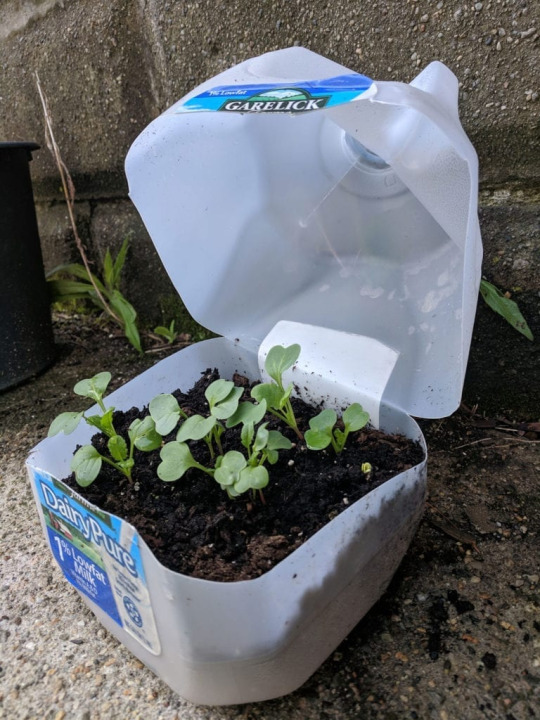
An easy way to clear up a section of lawn to create open gardening space is by using a sheet mulching or lasagna gardening method (though I like to call it the Cardboard Snuff-Out). Place cardboard or newspaper down in fall/winter to mark out where you want to garden. Layer compostable materials like grass clippings and wood chips on top of it, or potting soil/bagged compost. It’ll decompose over Winter into an organically rich bed that’ll have killed the grass and weeds underneath it. You don’t have to break out any tools and sweat over it come spring, and the cardboard itself will slowly decompose as well!

Though it's often recommended to plant things directly into the ground to decrease watering needs and increase nutritional independence, there’s plenty of reasons you may not be able to. Whether you’re renting, living in a place without a yard, or even just can’t or don’t want to break ground in a yard, you can still help biodiversity by growing in pots. Some plants have rather extensive root systems and aren’t well suited for pots, but there are still plenty of options available for plants that’ll boost biodiversity, be beautiful to look at, and grow just fine in pots! A recommendation is to get a larger pot, if you’re able, as it’ll hold onto more water and need watering less often. Not only are potted plants great for providing food for insects, but they can be shelter for other creatures too--there’s been a good few times I’ve moved a pot and found a frog or toad living underneath it.

If you don’t have room for pots on the ground, you could consider using hanging pots or window boxes! These can be great and easily-maintained options to provide food and habitat for insects and birds in an urban living situation like apartments or townhouses, but they can also be a fun way to add even more habitat to an already-robust home garden. You can even make an entire mini habitat in a window box or pot! I can personally say I’ve seen tons of pollinators visit my yearly hanging basket garden that consists of about five to seven plants, and I’ve always loved the idea of having a window box for blooms right out my window. Just make sure that it’s safe--make sure they’re securely fixed, and that whatever they’re hanging from can handle their weight when they’re freshly watered and loaded with plants.
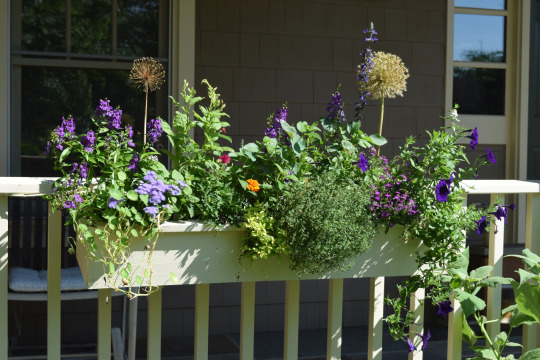
If you want to start indoors, you don’t necessarily need grow lights or heat mats (though it will make things a bit easier.) I’ve successfully grown milkweed, peppers, tomatoes, zucchinis, and even sprouted lemon seeds in college dorm rooms, and kept tomato and pepper plants in a dorm room on a sunny windowsill. For the most part, you need a nice and sunny window, some kind of container, and a source of heat (in my case, I used anything from a space heater to the warmth of my laptop running nearby. If you don’t have any sunny windows, or enough windowsill space to start plants on, its possible to obtain cheaper grow lights. One year, my mom bought me some gooseneck grow lights that could clip onto things for cheap off of Amazon. (Fair warning, though, they did light up my entire room in purple. I lived alone that year (covid year, my roomies bailed), so it was fine, but it was kind of trippy,)
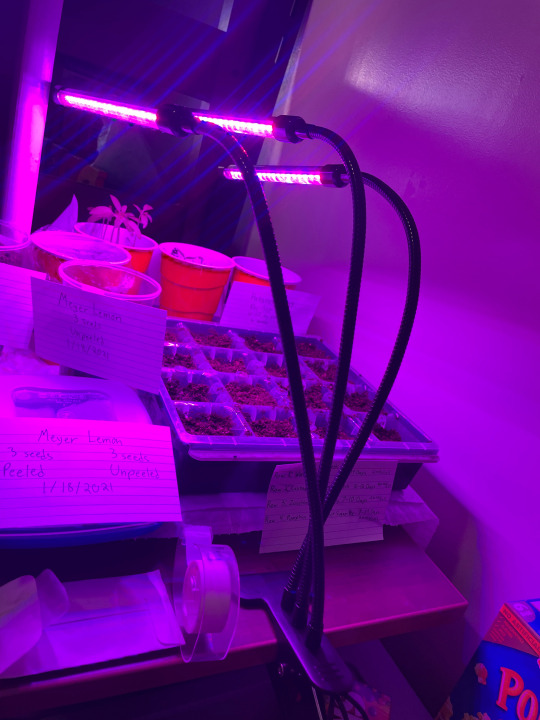
Another year, when I was in an apartment on my own, I bought a grow light modeled like a normal light bulb from the lightbulb aisle in Lowe’s and put it in my desk lamp. Growing seeds indoors can make them grow fast and leggy, so it’ll help if you can keep a desk fan on them so they focus on growing strong instead of tall and fast.
If you’re fortunate enough to have a friend with a nice set up, you could see if they’re willing to let you borrow some of their space to start your own plants as well! My set-up in college was by no means High Class, but I was still more than willing to start seeds for my friends who asked!
Containers for Seed Starting
So now that we’ve talked starting seeds indoors and out, we need to address what to start them in. It’s important that whatever you’re using has drainage holes, and be large enough to support your plant (starting something like milkweed or a squash in a tiny little pot won’t yield great results). Fortunately, there are options here!
If you’re looking to buy pots, Dollar Tree will sell some small plastic pots for cheap in the spring! They’re kind of thin, and won’t last forever, but they’re great for a few uses and don’t cost a lot of money. Something that’s a bit more pricey but are longer-lasting, in my experience, are the Burpee SuperSeed trays. They come in different sizes, but I’m fond of the 16-cell trays--they have silicone bottoms and are made of a nice solid plastic with a tray to hold water, so they hold up for a long time and are easy to clean and reuse!
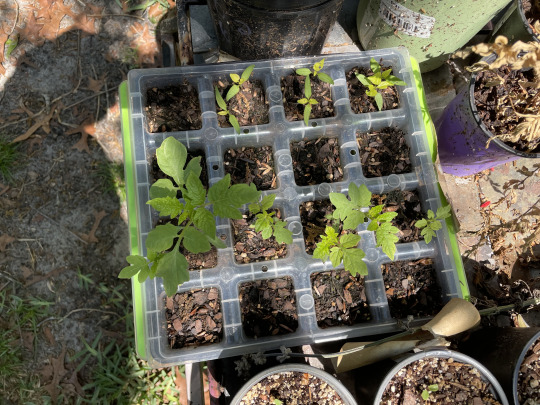
Burpee seed tray, my beloved.
What’s better than a cheap pot? Free ones, and there’s plenty of options there! I’ve seen people use toilet paper or paper towel rolls as pots by folding the bottoms in and have it work well for them! I think this method would work best if you had some kind of tray to keep them moist, because mine dried out fast last time I tried this method. I’ve also seen people make pots out of newspaper with a few different methods, and the people who use this method love it--apparently, the roots pass through the paper easier and it decomposes faster when buried, so you can just transplant the whole pot and avoid any kind of transplanting shock. If you don’t have any newspaper on hand, you can likely ask your friends or neighbors!

I’ve gotten lots of mileage from reusing old containers by poking a few holes in the bottom with knives or scissors--just be careful while you’re doing it! I, personally, am more likely to use an already-used solo cup for it--they’re a nice size, so they hold a good amount of soil and moisture and give the seedling a good amount of root space. I tend to write the plant information on the side of the cup in sharpie marker, or on an index card in pen. I’ve also heard of people making use of egg cartons, fruit containers, yogurt cups, milk cartons, soda bottles--the more you start thinking about what you could easily poke a hole in, the more options start coming around!
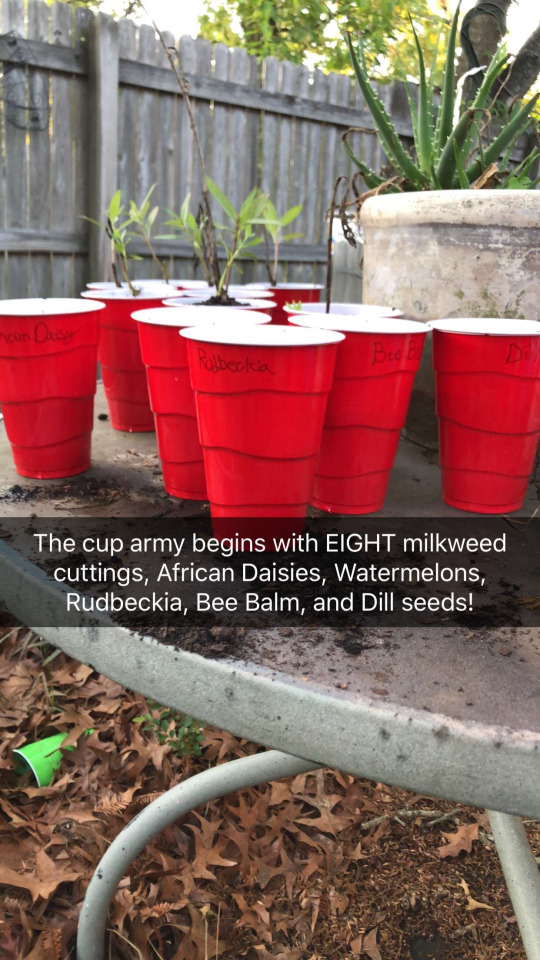
This photo may be from 2018, but I'll still regularly reuse cups like this! They're also great for cuttings!
As you start planning to move your seedlings into the ground and preparing planting sites, you’ll likely need a few tools to do it! How do you get these? You may be able to borrow some tools from a neighbor! As long as you make sure to return them in good condition, depending on how friendly your neighbors are, they might be totally fine with you borrowing their tools for awhile. If you don’t want to take that route, there may be a tool library you can borrow from, or a mutual aid group that can loan you tools for awhile. Either way, borrowing tools is cheaper than buying them--though, if you do have to buy tools, cheap hand-tools from Walmart or the dollar store work just fine. They’ll even last a good while if they’re taken care of when not in use! I've even seen places like Ross sell some tools and pots in spring!
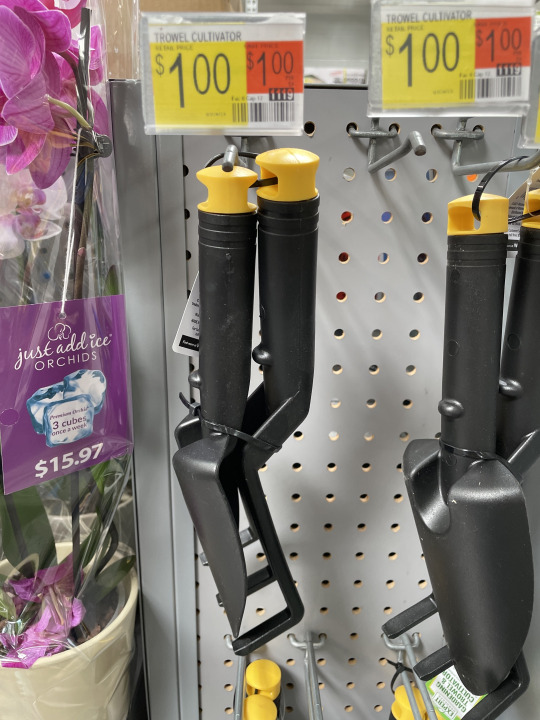
Spotted in a Walmart gardening section by the registers, 2023.
Of course, your mileage may vary with these. I genuinely cannot think of the last time my house got a newspaper, and as I've mentioned I don't have to worry about snow. Similarly, maybe you don't use plastic cups when you can help it, or don't have a particular affinity for eggs and yogurt. Maybe there isn't a tool library in your area--I sure don't know if there is in mine--but it could still be worth poking around and asking a neighbor!
That's the end of this post! My next post is gonna be about ways to support your plants for cheap--we're gonna be talking compost, mulch, and trellises. Until then, I hope this advice was helpful! Feel free to reply with any questions, your success stories, or anything you think I may have forgotten to add in!
#biodiversity#solarpunk#gardening#outdoor gardening#growing from seed#budget gardening#cheap gardening#indoor gardening#ani rambles#out of queue#the biodiversity saga#I can make a post later about how I prepare solo cups for being used as pots if yall want#I've found its safest to just use a nice pair of scissors and keep the cup upside-down on the table while I cut into the bottom#and when i say 'take care of the tools when not in use' i mean 'dont be me and leave a cheap shovel from dollar tree out in the rain'#it had a wooden handle and it basically just like. rotted. fell apart in my hand when I picked it up#generally keeping tools in the garage will also help them not rust as fast too#but if you're gonna leave them outside at least put them in shade#the number of times i have lost feeling in my hands because i picked up a hoe that was laying in the sun and fuckin SCALED my palms#its not fun. dont do it. maybe its a Floridian problem but still#if you read all these tags. uh. shovel emoji. idk. sorry dude.
216 notes
·
View notes
Photo




Don’t just integrate yourself with nature, integrate the whole system.
Solarpunk question: Could we use genetically engineered “super trees” as structural bases for human infrastructure?
How would you integrate nature into our systems as a species?
#solarpunk#solar#punk#ecopunk#cottagecore#ecology#ecofriendly#eco movement#solarpunk art#greenhouse#tree#artificial intelligence#ai#art#painting#treehouse#treehouses#apartment#city design#urban#design#cityscape#imagine#optimisticfutures
250 notes
·
View notes
Photo



Product Review: Window Solar Charger
Company/Website: Grouphug Solar
Does it work: Yes. I tested it by using it to charge my cellphone.
Price: $149, I bought mine on sale for $129.
Operation: You’re looking at it.
The button turns on yellow, red, or green LED lights that tell you whether the panel is getting enough light to operate, and how charged it’s (included) battery is, but it will charge your devices whether you ever push this button or not.
Assembly/Installation: Comes out of the box fully assembled as shown. Stick the included suction cup to a window and hang it up.
Overall: I like it. You get what you pay for. It does one thing, but it does it well, and I’ve seen desk lamps that were more complicated to use.
I am not affiliated with Grouphug Solar, nor am I making any money off this.
#solar#apartment living#solar panel#Grouphug Solar#window solar#product review#solarpunk#literally a wire window ornament
115 notes
·
View notes
Text
.
#hate the people who voted for the sims castle dlc#we already have a couple dlc with that stuff and there's tons of cc#i wanted to build cool cyberpunk/solarpunk apartments you assholes
7 notes
·
View notes
Text
Boggon Street Residentials - No CC


Type: Apartment (9 units)
Cost: 1.767$ and 2.050$
Requires: All EPs and SPs
Recommended mods: Rug Fix, Centerpiece Enabler,Rent Furnished Apartment
Here the DOWNLOAD links
SFS - MEDIAFIRE
More info below ⬇⬇⬇⬇⬇⬇⬇⬇⬇


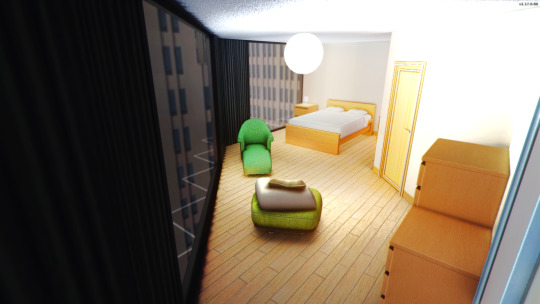



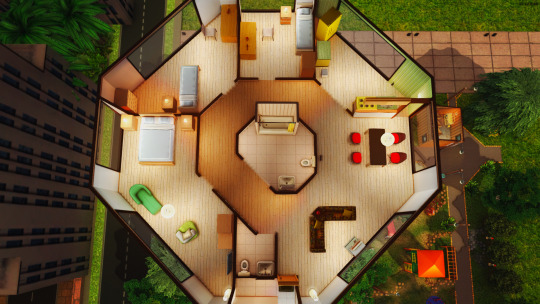
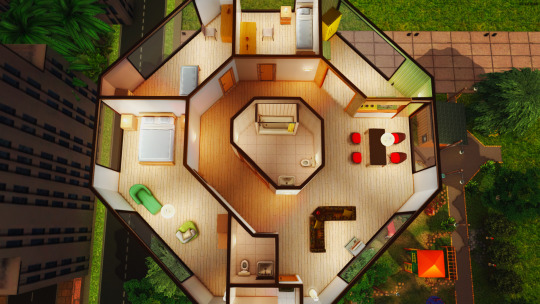


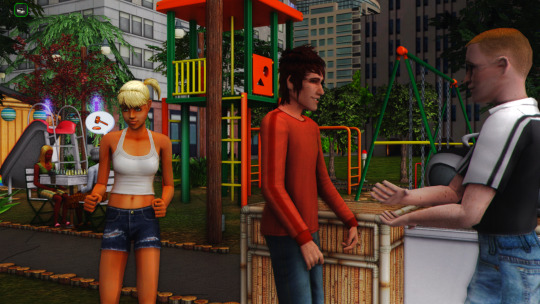
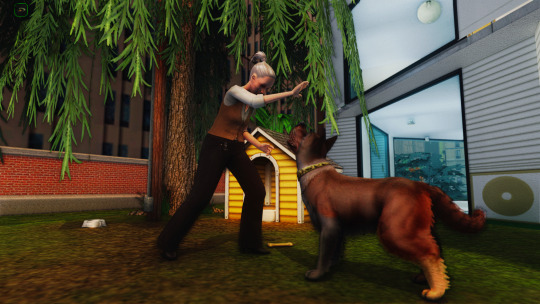

MORE Pics ⬇⬇⬇⬇⬇⬇⬇⬇⬇
Full work in progress pics and details
Apartment lot 40 x 60
a few parking slots
a few cars
a lot of crafting and badges
green areas
3 fruit trees
a gym area
achess
abookshelf
a kite
a painting table for child
a basketball court
a full Play Ground
a fireplace
a campfire
lodge fun pool
hammock
a barbecue spot
counters and fridge
buffettable
acoffee machine for all
easel
communal showers
diapers changing table
public WCs
only elevator
#ts2#sims 2#the sims 2#urban#wip#scifi#no cc#nocc#urban fantasy#sims2#work in progress#apartment#city#futuristic#future#green#solarpunk#parks#outdoor#boggon street residentials#dl: apartment#dl: lot#My own lots
40 notes
·
View notes
Text





interior of a split level courtyard, stacked and interlocked stone blocks, vertical space, Vaperwave, pastel styling of cyan pink and light green pastel, extremely coherent, walkway, high detailed, style of frank lloyd wright, flowering plants and ivy growing on the stones, bright neon signs billboards lights, focus, solarpunk, apartment balconies, raytraced lighting, Masaaki Sasamoto, Fritz von Uhde
#interior courtyard#Vaperwave#pastel styling#frank lloyd wright#flowering plants#ivy#bright neon signs#solarpunk#apartment balconies#Masaaki Sasamoto#Fritz von Uhde
37 notes
·
View notes
Text
youtube
Many offices are sitting empty following the rise of working from home, while cities around the world face housing crises. Building new housing is extremely carbon intensive. Could converting unused offices into housing help solve both problems?
#planeta #officeconversion #greenbuilding
We're destroying our environment at an alarming rate. But it doesn't need to be this way. Our new channel Planet A explores the shift towards an eco-friendly world — and challenges our ideas about what dealing with climate change means. We look at the big and the small: What we can do and how the system needs to change. Every Friday we'll take a truly global look at how to get us out of this mess.
Credits:
Reporter: Dave Braneck
Camera: Henning Goll
Video Editor: Frederik Willmann
Supervising Editor: Joanna Gottschalk
Factcheck: Jeannette Cwienk
Thumbnail: Em Chabridon
Interviewees:
Steven Paynter, Principal Architect, Gensler
Lily Langois, City Planner, San Francisco Planning Dept.
Pernilla Hagbert, KTH Royal Institute of Technology
Benjamin Albrecht, Director of Development, International Campus
Marcus Gwechenberger, Head of Planning, Frankfurt
Read more:
US federal government incentivizing office to housing conversions: https://www.whitehouse.gov/cea/writte...
Some of the physical challenges of converting offices into housing: https://www.nytimes.com/interactive/2...
Chapters:
0:00 Intro
0:51 The Vacancy Problem
2:31 Housing’s environmental Impact
4:12 Adaptive Reuse
6:55 Improving City Planning
8:53 Cutting Red Tape
10:38 Potential
#dw planet a#solarpunk#architecture#buildings#housing#office building#apartment buildings#office#appartement#USA#homelessness#city planning#housing crisis#Youtube
2 notes
·
View notes
Text
oh to live in an earthship someday
#i wanna visit one#im gonna go and stay in one#where the fuck is taos#hold up i could go visit my friend in utah and then go stay in an earthship#for a week#that sounds incredibly expensive#thinking#elk's trash#i read this article on earthships that was basically tearing the whole idea apart and explaining why they weren't ''all that''#but come on dude#you're missing the point of solarpunk: finding solutions#you do a better job#you give criticism#then you supply better ideas#this is why we're never gonna get anywhere we profit off of unconstructive criticism
10 notes
·
View notes
Note
Hello! I live in a very small efficiency apartment where there is not a lot of wi dow space/the window is glued shut and the land is exclusively owned and maintained by the company. What can I do to incorporate more solarpunk practices into my life? Are there any plants that can still grow well indoors? I'm afraid to start up a water station or anything like that outside because I'm afraid maitenance will mess with it/remove it. Would it be better for me to do something like knitting/embroidery that I can more easily do indoors?
Hello! As a fellow apartment-dweller with not a lot of window space currently, I feel your struggle here. If you're concerned that maintenance will mess with anything you put outside, then it probably is best to focus on things you can do indoors. However, there are quite a few things you can do indoors!
Plants: If you're looking for experience growing things, there are a variety of plants that grow well indoors and with low light - here's one list. (I've heard spider plants and snake plants recommended to beginners a lot, but I've never personally grown either.)
Fiber crafts: If you're more interested in crafts like knitting and embroidery, go for it! I also recommend people who are interested in those types of things learn about mending as well - it's a great way to extend the life of your old clothes (and other things made of fabric) and reduce the amount you need to buy.
Cooking: Cooking is a great skill to have, but it can be a challenge in an efficiency apartment. If you have a cooktop or a crock pot, you can look for simple recipes that you can make with the space and tools you have.
Building community: One of the foundations of solarpunk is that it's about community. My favorite way to start, especially in apartments, is by meeting the neighbors. Introducing yourself is a great way to open a relationship. Tying in with the previous idea, if your entire building is full of efficiencies and you can cook a big batch of something in a crock pot, that's a great excuse to have some neighbors over for a home-cooked meal.
Share: Part of building community, it doesn't require any outdoor space. You and your neighbors could put together a shared pantry in your building. You could start a Free Box at your workplace. Talk to the people around you - what do they need?
Get involved: Solarpunk isn't just about growing plants and mending clothes - there's also an activism component that is how we change society as a whole. Volunteer with an organization doing things you care about. Find a local mutual aid group (here's some tips for how to find them) and see what you can do to get involved. Start your own mutual aid project. The size of your apartment is irrelevant if you're out doing things.
Research: Not being able to do things outside right now doesn't mean you can't learn about them. And many of those "big picture" ideas have a lot of concepts that can apply to the efficiency apartment life. Looking into the "7 R's" or permaculture can help you come up with ideas for more things you can do.
Also if you're really set on doing stuff outdoors, don't necessarily discount it, especially if you plan to be in this apartment for a while! You can propose outdoor projects to your apartment complex's manager. They may be more receptive than you think, especially if you can spin it to sound beneficial to them. (If you're proposing a community garden for residents, for example, it could be a draw for new residents, convince current residents to stay, be managed by you the residents so they don't have to do much to maintain it, and they won't have to pay their landscapers to mow/maintain that space anymore.)
Check out more ideas in these tags:
#apartment solarpunk
#dorms and small spaces
#community building
#activism
#fiber crafts
There's also some additional tips in this post and this post, which are earlier responses to similar asks.
I hope this helps! Followers, feel free to chime in with your best tips!
- Mod J
165 notes
·
View notes
Text
Something that I think should be an important part of solarpunk aesthetics is screws.
Look at your smartphone. No screws. You've got to have specialized tools to get inside your phone to repair something. There are certain pieces of tech that are glued in place and glue can't be undone without permanently breaking the bond.
But screws!
You can take apart a broken old radio, repair what's broken, and, if you were careful in taking it apart, you can put it back together and have a fully functioning radio and all you need is a common screwdriver!
It's hard to build screws and other mechanical fasteners because it requires more planning than clamps and glues, but isn't that what solarpunk is all about‽ It's about care and sustainability and and a radio or a computer built carefully with repair in mind is a sustainable computer that stays out of landfills and in use.
22K notes
·
View notes
Text
I think we a group need to consider what the early “zero waste” movement did in the 2010s. You know. They’d keep “all” their waste in a glass jar, live in a nice apartment somewhere in LA where they had easy access to a refill store and didn’t stop to consider that just existing in the US creates waste they couldn’t see.
I remember watching a video in 9th grade (around 2013) about a chick who did that and even then I was like “that’s bullshit” and it really turned me off the zero waste movement.
The inherent classism of a lot of zero waste purists created a wall between me and them, where instead of them admitting their privilege, they simply said “anyone can do this”. Most people can’t. A zero waste refill store does not exist in my state! Sure, I could try online but this is 1. More expensive- something my dirt poor family could not do at the time and 2. Creates more carbon emissions!
This isn’t to say zero waste is bad- it’s simply a standard most Americans can’t reach. I think this is why I’m so drawn to solarpunk, because I think solarpunk recognizes the classism that is in a lot of eco-friendly products and movements (something I do think is being addressed- I’ve seen more affordable products now than I did in high school). Solarpunk includes diy- reusing packaging that many of us still have to buy because we can’t afford the eco-friendly version.
Idk I just had some thoughts
4K notes
·
View notes
Text
The FTC has Big Pharma’s number

On November 27, I'm appearing at the Toronto Metro Reference Library with Facebook whistleblower Frances Haugen.
On November 29, I'm at NYC's Strand Books with my novel The Lost Cause, a solarpunk tale of hope and danger that Rebecca Solnit called "completely delightful."

The most consistent bright spot in the dark swirl of US politics is the competence of the Biden Administration's progressive enforcers: people like Rohit Chopra, Jonathan Kanter and Lina Khan, who keep demonstrating just how far a good administrator can go. Anyone can have a vision, but knowing how to execute is the difference between hot air and real change:
https://pluralistic.net/2023/10/23/getting-stuff-done/#praxis
Take a minute to contrast Biden's administrators with Trump's: Trump's administrators had an ideological vision just as surely as Biden's do, and Trump himself had a much more pronounced and explicit ideology than Biden, whose governance style is much more about balancing the Democratic Party's blocs than bringing about a specific set of policies:
https://pluralistic.net/2023/03/06/personnel-are-policy/#janice-eberly
But whatever clarity of vision the Trump administration brought to DC was completely undermined by its incompetence (thankfully!). Apart from one gigantic tax break, Trump couldn't get stuff done. He couldn't deliver, because he'd lose his temper or speak out of turn:
https://pluralistic.net/2023/11/14/when-youve-lost-the-fedsoc/#anti-buster-buster
And his administrators followed his lead. Scott Pruitt was appointed to run the EPA after a career spent suing the agency. It could have been the realization of his life's dream to dismantle environmental law in America and open the floodgates for unlimited, wildly profitable corporate pollution and pillaging. But the dream died because he kept getting embroiled in absurd scandals – like the time he sent his staffers out to drive around all night looking for a good deal on a used mattress:
https://www.nbcnews.com/politics/politics-news/epa-s-pruitt-told-aide-obtain-old-mattress-trump-hotel-n879836
Or his insistence on installing a CIA-style "Sensitive Compartmented Information Facility" (SCIF) so he could play super-spy while reading memos:
https://www.cnn.com/2018/04/26/politics/epa-administrator-scott-pruitt-sound-proof-booth-scif/index.html
Or the time he sent his security detail to the Ritz-Carlton to demand that they supply him lots of little bottles of his favorite hand-cream:
https://www.vox.com/2018/6/7/17439044/scott-pruitt-ritz-carlton-moisturizing-lotion
There were other examples in the Trump administration, but Priutt is such a good case-study. He's like a guy who spent his whole life training to compete in the Olympics, and finally got a shot, only to be disqualified for ordering too much room-service in the Olympic Village. Priutt was wildly ambitious, but he was profoundly undisciplined – and wildly incompetent.
Compare that with Biden's progressive enforcers and agency heads, who showed up on the first day of work with an encyclopedic knowledge of their administrative powers, and detailed plans for using them to transform the lives of the American people for the better:
https://pluralistic.net/2022/10/18/administrative-competence/#i-know-stuff
The Biden administration's competence translates into action, getting stuff done. Maybe that shouldn't surprise us, given the difference between the stories that reactionaries and progressives tell about where change comes from.
In reactionary science fiction, we enter the realm of the "Competent Man" story. Think of a Heinlein hero, who is "able to change a diaper, plan an invasion, butcher a hog, conn a ship, design a building, write a sonnet, balance accounts, build a wall, set a bone, comfort the dying, take orders, give orders, cooperate, act alone, solve equations, analyse a new problem, pitch manure, program a computer, cook a tasty meal, fight efficiently, die gallantly."
In Competent Man stories, a unitary hero steps into the breach and solves the problem – if not single-handedly, then as the leader of others, whose lesser competence is a base metal that the Competent Man hammers into a tempered blade:
https://tvtropes.org/pmwiki/pmwiki.php/Creator/RobertAHeinlein
Contrast this with a progressive tale, like, say, Kim Stanley Robinson's Ministry For the Future, where the Competent Man is replaced by the Competent Administration, in which people of goodwill and technical competence figure out how to join forces to create population-scale architectures of participation that allow every person to contribute their skills and perspective:
https://pluralistic.net/2020/12/03/ministry-for-the-future/#ksr
The right's whole ideology insists that the world can only be saved by Competent Men. As Corey Robin writes in The Reactionary Mind, the unifying factor that binds together conservative factions from monarchists to racists to Christian Dominionists is the belief that a few of us are born to rule, and the rest to be ruled over:
https://pluralistic.net/2020/05/25/mafia-logic/#mafia-logic
The Reaganite insistence that governments are, by their very nature, incompetent and malign ("The nine most terrifying words in the English language are, 'I’m from the government, and I’m here to help'"), means that conservatives deny the possibility of a Competent Administration.
When conservatives take office and proceed to bungle the most basic elements of administration, they're fulfilling their own campaign narrative, which starts with "We must dismantle the government because it is bad at everything." Conservatives who govern badly prove their own point, which explains a lot about the UK Tory Party's long run of governmental failure and electoral success:
https://apnews.com/article/uk-suella-braverman-fired-cabinet-shuffle-7ea6c89306a427cc70fba75bc386be79
There's a small mercy in the fact that so many of the most ideologically odious and extreme conservative governments are so technically incompetent in governing, and thus accomplish so little of their agendas.
But the inverse – the incredible competence of the best progressive administrators – is nothing short of a delight to witness. Here's the latest example to cross my path: the FTC has intervened in a lawsuit over generic insulin pricing, on an issue that is incredibly technically specific and also fantastically important:
https://www.fiercepharma.com/pharma/ftc-blasts-pharmas-abuse-fda-patent-system-sanofi-mylans-insulin-monopoly-lawsuit
The underlying case is before the FDA, and it concerns the dirty tricks that pharma giant Sanofi used to keep Mylan from making a generic version of Mylan's Lantus insulin after its patent expired.
There's an explicit bargain in patents: inventors can enlist the government to punish their rivals for copying their ideas, but in exchange, the government demands that the inventor has to describe how the invention works in a detailed patent filing, and when the patent expires, 20 years later, rivals can use the patent application as instructions for freely copying and selling the invention. In other words: you get 20 years of exclusive rights in return for facilitating your competitors' copying and selling your invention when the 20 years are up.
Pharma doesn't like this, naturally: not content with 20 years of exclusivity, they want the government to step in and punish their competitors forever. In service to that end, pharma companies have perfected a process called evergreening, where they dribble out ancillary patents after their initial filing, covering minor reformulations, delivery systems, or new uses.
Evergreening got a moment in the public eye earlier this year, with John Green's viral campaign to shame Johnson & Johnson out of using evergreening to restrict poor countries' access to TB medication:
https://armandalegshow.com/episode/john-green-part-1/
The story of pharma is that it commands gigantic profits, but it invests those profits into medicines that save our lives. The reality is that most of the key underlying pharma research is publicly funded (by Competent Administrators who apportion funding to promising scientific inquiry). Pharma companies' most inventive genius is devoted to inventing new evergreening tactics:
https://pluralistic.net/2023/10/19/solid-tumors/#t-cell-receptors
That's where the FTC comes in, in this Sanofi-Mylan case. To facilitate the production of generic, off-patent drugs, the FDA maintains a database called the "Orange Book," where pharma companies are asked to enumerate all the ancillary patents associated with a product whose patent is expiring. That way, generics manufacturers who make their own version of these public domain drugs and therapeutics don't accidentally stumble over one of those later patents – say, by replicating a delivery system or special coating that is still in patent.
This is where the endless, satanic inventiveness of the pharma sector comes in. You see, US law provides for triple damages for "willful patent infringement." If you are a generics manufacturer eyeing up a drug whose patent is about to expire and you are notified that some other patents might be implicated in your plans, you must ensure that you don't accidentally infringe one of those patents, or face business-destroying statutory damages.
So pharma companies stuff the Orange Book full of irrelevant patent claims they say may be implicated in a generic manufacture program. Each of these claims has to be carefully evaluated, both by a scientific team and a legal team, because patents are deliberately obfuscated in the hopes of tricking an inattentive patent examiner into granting patents for unpatentable "inventions":
https://blueironip.com/patents-that-hide-the-ball/
What's more, when a pharma giant notifies the FDA that it has ancillary patents that are relevant to the Orange Book, this triggers a 30-month delay before a generic can be marketed – adding 2.5 years to the 20 year patent term. That delay is sometimes enough to cause a manufacturer to abandon plans to market a generic drug – so the delay isn't 2.5 years, it's infinite.
This is a highly technical, highly consequential form of evergreening. It's obscure as hell, and requires a deep understanding of patent obfuscation, ancillary patent filings, generic pharma industry practice, and the FDA's administrative procedures.
Sanofi's Orange Book entry for Lantus insulin listed 50 related patent claims. Of these, 48 were invalidated through "inter partes" review (basically the Patent Office decided they shouldn't have allowed these claims to be included on a patent). Neither of the remaining two claims were found to be relevant to the manufacture of generic Lantus.
This is where the FTC's filing comes in: their amicus brief doesn't take a position whether Sanofi's Orange Book entries were fraudulent, but they do ask the FDA to intervene to prevent Orange Book stuffing because "improper listings can cause significant harm to competition and consumers."
This is the kind of boring, technical, important stuff that excellent administrators can do. The FTC's brief is notice to the FDA that it should amend its procedures to ban (and punish) Orange Book abuse. That will make it possible for you, a person who needs medicine, to get that medicine more cheaply and quickly. In America's pay-for-use privatized healthcare hellscape, this could be a life-or-death matter.
There's plenty of things the Biden administration is getting very, very badly wrong, but we shouldn't lose sight of how its progressive wing is making real, lasting change for the better. Competent Administrations are the true peoples' champions. They beat Competent Men every time.

If you'd like an essay-formatted version of this post to read or share, here's a link to it on pluralistic.net, my surveillance-free, ad-free, tracker-free blog:
https://pluralistic.net/2023/11/23/everorangeing/#taste-the-rainbow
608 notes
·
View notes
Text
For Solarpunk aesthetic week I finally after like a year of putting it off mended a pair of threadbare pyjama pants I wear constantly. They didn't have holes yet but you could see my fingers through the fabric when I put my hands inside them. It took me most of the afternoon because I kept getting distracted. So I finally put on an audiobook and then hyperfocused so hard I missed my chance to take the bus to therapy. The ADHD has been bad today but! I got something I had been putting off done!
I used size 10 crochet cotton because it's what I had that wasn't embroidery floss (which I didn't want to use because it's not as durable since it's meant to come apart). The fabric was scrap fabric leftover from one of the shirts I made into a crop top this summer.
Patch leg one (inside and outside)

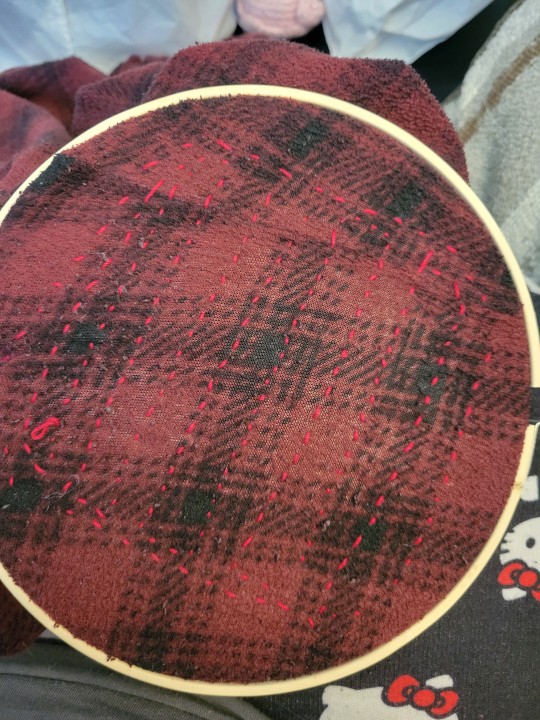
Patch leg two (inside and outside)

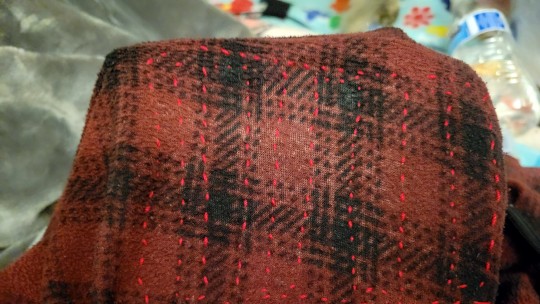
It's hard to tell but the second patch has much neater stitches. I also stitched down the ends of thread in the second one.
Finally! I have done the thing! Next is a shirt I found a small hole in, but since the hole is small I am going to just use embroidery thread to fix it.
263 notes
·
View notes